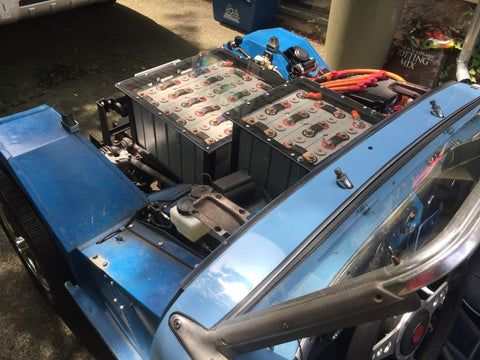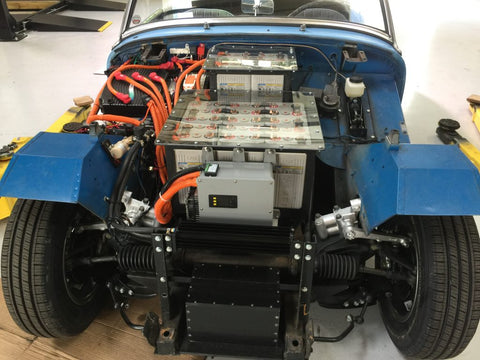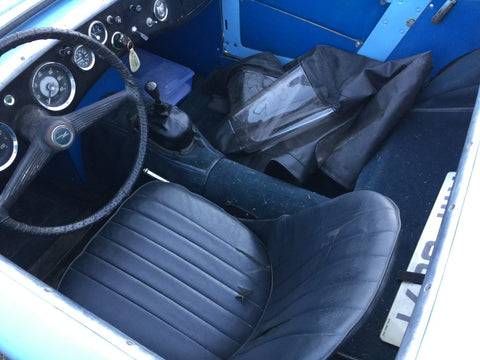Our Electric Frog-E in Automobile Magazine
We are excited to see our Frog-E electric featured in Automobile magazine’s Website this week. Click below to give it a read.
Electrifying news

FrogE #2 is nearly done and nearly ready to send to its home in Maryland. We have just a bit more testing to do, including a long highway drive next Sunday September 29 to the Fairfield County Concours in Westport, CT, where the car will be displayed as part of an exhibit highlighting electric sports cars. Come say hello!

This week, we changed the rear leaf springs and raised the car, then shimmed it down to the right height. You might be able to see the difference from the photo we shared last week. Now the car sits with a few inches gap between the fender tops and the top of the tire (at 12 o’clock). It was bottoming out and hitting the bump stops on hard bumps with the original (and sagging) springs in place, and the new springs fixed that issue and dramatically improved the ride quality.

Our biggest recent breakthrough was to boost the charger peak voltage so that we could finally determine maximum range for this particular battery configuration. It turns out we have 81 miles of range, with combined highway and city driving.
I drew the short straw to verify actual range in the field. The onboard volt meter tells us the capacity but this is non-linear chemistry, so range is not directly correlated to voltage. The volts stay stable for most of the capacity, and then fall off rapidly when the pack is running low. Off I went to determine the actual range on the road. Ironically, many Sprite fuel gauges read full until you have burned half a tank, and then the gauge falls more rapidly. The electric “fuel” gauge behaves in a similar fashion.

At 81 miles traveled, the controller derated and reduced available power, which told me it was time to pull over NOW. Adjacent at this moment was the house of the fellow who does our landscaping, and I figured he might just have an extension cord to help me make it back to the shop. There was no answer at the front door, but sure enough, in the driveway I found a 50 foot extension cord next to an outdoor 110 outlet, and I immediately plugged into the grid.

In this moment, it sure seemed like finding power was easy… just turn down any driveway and fill ‘er up. 110 power limits the rate of charge though, so it’s really only for emergencies. The 220 charger in our shop is quite a bit faster, and public charging stations are faster still. Regardless, this was what I needed to make it home, and after an hour of smart phone calls and emails, I coiled up the extension cord and hit the road.

We had hoped for more range, but this particular battery pack (and other factors) limit us to roughly the 80 mile mark. We always have the option of supplementing our range with a Tesla pack… these batteries have a greater energy density, and while they are only available used, they should have a 20 year lifespan so this is an option for people who need to travel further on a single charge.
That said, having lived with this car for a few months of testing, I was surprised how long it takes to use-up a full charge. It’s rare that we set out for an 80 mile Bugeye drive, and I suspect it’s rare for our customers to do the same. Sure, there are some folks who routinely make long trips, but they’re probably not interested in electrics for that application anyway, at least not yet.

Most of our Bugeye outings have been relatively short hops of 20 miles or less. Here in the Northeast, that works nicely, and a 20 mile drive takes us where we need to go and provides ample time to enjoy a fun drive in a Sprite. Thus, I have become convinced that 80 mile range works just fine, especially if you recharge after every 20 mile journey, and depart each day with a full 80 mile range. For most customers, that’s ample capacity to head to the beach or apple orchard, run some errands, or go visit a friend, and return home for a recharge, with ample reserve.

This week, we will be upgrading the car’s onboard charger so that it charges twice as fast. This will make off site charging sessions twice as productive. The more powerful charger will allow us to completely fill the discharged batteries in 8 hours, and to also boost 25% more range from the system with a two hour public charging station stop. For example, 100 mile range can be attained with a two hour boost stop.
I have a 72 mile round trip journey to Westport next weekend for the concours. I’ll probably plug in for 30 minutes at the Westport train station before I head home, just to play it safe.
Come for a nose-off video drive in our second FrogE electric Sprite

Our second electric is ready for range and systems testing!
The nose is now on, and notice the lexan grill cover, meant to improve the aerodynamic drag of that usually open big mouth. Better aero=better range! Cooling air is no longer needed.

Come for a drive in the video below!
Below you can see the finished car, which was truly rescued by this electric conversion. This car sat for ages and was slowly returning to the earth, until our customer asked if we could revive the vehicle with electricity, and now he has taken a dormant asset in his garage and turned it into a delightfully smooth machine.

We’ve dressed up the car with new wheels and tires as well as a new interior and tonneau. It’s nicer than ever, but not so nice that you can’t drive and enjoy it. We’ll soon send her back home to Maryland, where the car will share the garage with a Tesla.
FrogE electric Bugeye number two nears completion
We’ve begun drive testing on FrogE #2, destined for a customer in Maryland. We are not done yet, but here are pictures of our progress to date. This car uses different batteries than car #1, with a goal of increased range. Below you can see the completed battery array, complete with Ferrari-like lexan viewing panels over the battery cells.

Above you can also see the heat exchanger in the radiator brackets, 220 charger (in front of the batteries) and the single master cylinder for the brake pedal. We would love to sell electric conversion kits, but the complexity is such that for now we can only do conversions in our building. Call if you would like us to pick up your car and bring it here for conversion. Our trucks can go anywhere. Until we can simplify this installation, our kits will have to wait, unless you are a very skilled installer.

Above you can see the framework Kenny designed to hold our batteries. This cage will allow the entire battery assembly to lowered in place with an engine hoist. You can see the blue AC electric motor in the photo above, in the transmission tunnel, where it lives low and aft.

Above you can see the level 2 (220) charge plug in place in the flip-up filler cap. We had to modify the cap to allow use of the charging station plug to fit, but we are very happy with the result. Car #1 had a 110 plug in the filler neck, but this charger allows both a 110 and 220 plug in the same receptacle with an adaptor. So car #2 has one recharge receiver instead of two.

Notice also the larger brake pedal and absence of a clutch pedal
Above you can see the nearly complete new blue interior. Below is how we got the car. While here, this car has received a new welded up dashboard with navy blue cover and new electronic gauges that speak to the electric systems on board. One big challenge is routing the wires from the rear of the car to the forward compartment. We built a fat box over the inner rocker panel on the passenger side which serves as a soffit for the wires. You can just see that the inner rocker panel cover is a bit thicker than usual because of the heavy wires that run inside. In this way, we can hide the wires that communicate between front and rear of the car.
New seats and steering wheel go in next! We’ll have more pictures next week of the completed car!

FrogE Electric Bugeye Sprite top speed run
Top speed is not often discussed in the Frogeye-sphere. But we are in the sure-footed business. And each week we take another rattling car that should not be driven above 40 or so mph and turn it into a highway capable roadster.

Our electric cars are particularly capable, because we know upfront that the power plant puts the car in another league, and everything has to be set up right because they go fast in a (relative) hurry.
While out in FrogE number one the other day, I had to see what kind of top speed is possible for an electric Bugeye. Our GPS speedometer captures top speed as one of it’s many functions, which it saves as shown in the photo above. This photo was taken after the drive while in the garage.
Note that the analog needle stops at 100 and the peak digital meter seems to be without limits…

The amazing 1659 pound electric FrogE Sprite.
I had my first off-site FrogE charging session this week, at the Westport, CT train station, next to two BMW SUVs (as shown below). It was quite novel to plug-in a fuel nozzle for free, and I didn’t tire of watching the kilowatts flow.
Is this how most filling stations will look in 50 years?

Two electric SUVs and one electric SV.
Our big electric car news this week is the results from a session on four scales to measure the total weight of the car and the weight distribution. Below are the numbers for the FrogE electric #1 (seen above). The car weighs 1659 pounds, just 78 pounds more than the gas Bugeye we weighed about a year ago. That gas car had just 1/3 fuel on board. Were the tank full, the weight differential between the cars would be a mere 46 pounds. We’re excited that our electric is just roughly 50 pounds heavier when loaded enough batteries for a 100 mile range.

Near perfect 50/50 weight distribution in the electric FrogE
Even more exciting is the weight distribution. Above you can see perfect 50/50 weight distribution for the electric car, even better than the gas car below. No wonder the FrogE handles so nicely.

Close to 50/50 weight distribution in a gas-powered Bugeye, 1/3 fuel load

